The NVIDIA GeForce GTX Titan X Review
by Ryan Smith on March 17, 2015 3:00 PM ESTOverclocking
Finally, no review of a GTX Titan card would be complete without a look at overclocking performance.
From a design standpoint, GTX Titan X already ships close to its power limits. NVIDIA’s 250W TDP can only be raised another 10% – to 275W – meaning that in TDP limited scenarios there’s not much headroom to play with. On the other hand with the stock voltage being so low, in clockspeed limited scenarios there’s a lot of room for pushing the performance envelope through overvolting. And neither of these options addresses the most potent aspect of overclocking, which is pushing the entirely clockspeed curve higher at the same voltages by increasing the clockspeed offsets.
GTX 980 ended up being a very capable overclocker, and as we’ll see it’s much the same story for the GTX Titan X.
| GeForce GTX Titan X Overclocking | ||||
| Stock | Overclocked | |||
| Core Clock | 1002MHz | 1202MHz | ||
| Boost Clock | 1076Mhz | 1276MHz | ||
| Max Boost Clock | 1215MHz | 1452MHz | ||
| Memory Clock | 7GHz | 7.8GHz | ||
| Max Voltage | 1.162v | 1.218v | ||
Even when packing 8B transistors into a 601mm2, the GM200 GPU backing the GTX Titan X continues to offer the same kind of excellent overclocking headroom that we’ve come to see from the other Maxwell GPUs. Overall we have been able to increase our GPU clockspeed by 200MHz (20%) and the memory clockspeed by 800MHz (11%). At its peak this leads to the GTX Titan X pushing a maximum boost clock of 1.45GHz, and while TDP restrictions mean it can’t sustain this under most workloads, it’s still an impressive outcome for overclocking such a large GPU.
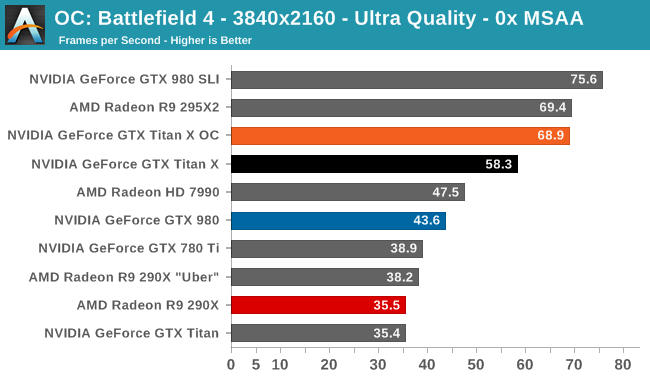
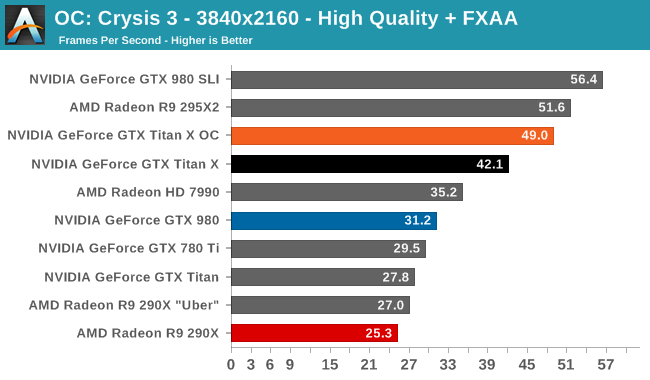
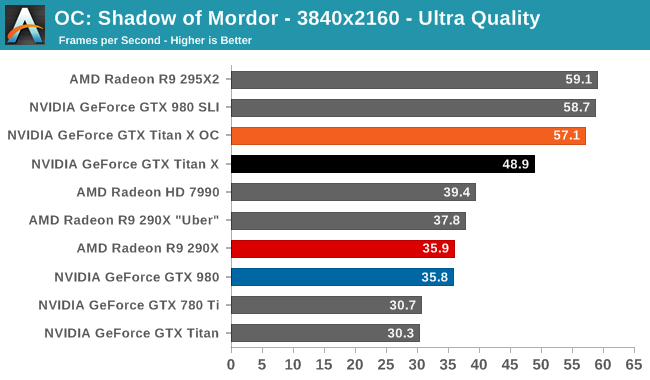
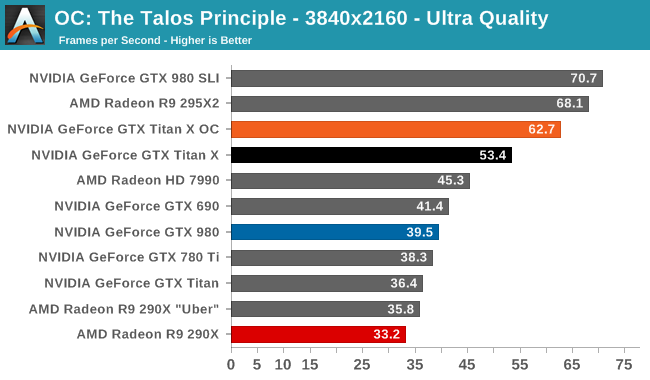
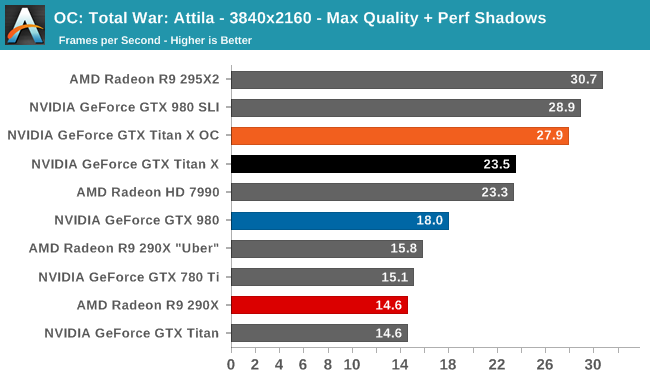
The performance gains from this overclock are a very consistent 16-19% across all 5 of our sample games at 4K, indicating that we're almost entirely GPU-bound as opposed to memory-bound. Though not quite enough to push the GTX Titan X above 60fps in Shadow of Mordor or Crysis 3, this puts it even closer than the GTX Titan X was at stock. Meanwhile we do crack 60fps on Battlefield 4 and The Talos Principle.
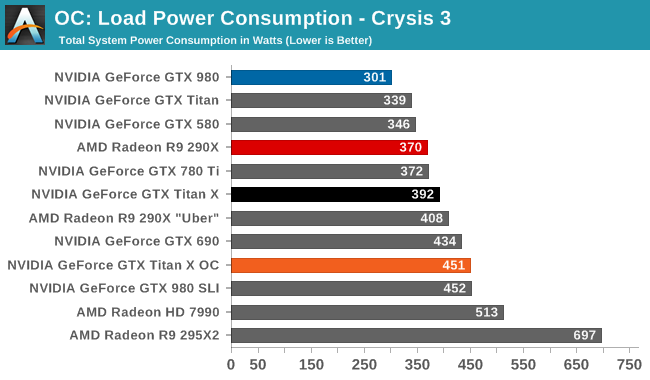
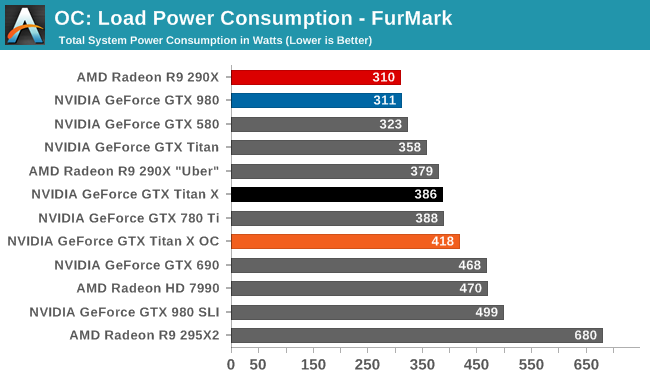
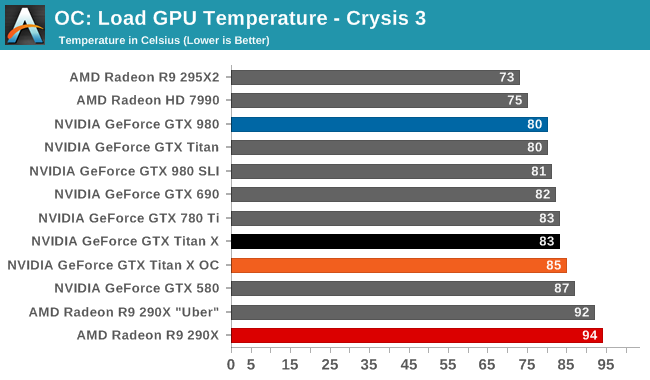
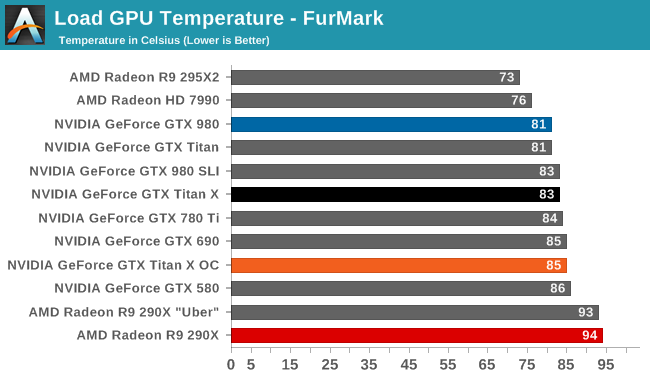


The tradeoff for this overclock is of course power and noise, both of which see significant increases. In fact the jump in power consumption with Crysis is a bit unexpected – further research shows that the GTX Titan X shifts from being temperature limited to TDP limited as a result of our overclocking efforts – while FurMark is in-line with the 25W increase in TDP. The 55dB noise levels that result, though not extreme, also mean that GTX Titan X is drifting farther away from being a quiet card. Ultimately it’s a pretty straightforward tradeoff for a further 16%+ increase in performance, but a tradeoff nonetheless.










276 Comments
View All Comments
modeless - Tuesday, March 17, 2015 - link
This *is* a compute card, but for an application that doesn't need FP64: deep learning. In fact, deep learning would do even better with FP16. What deep learning does need is lots of ALUs (check) and lots of RAM (double check). Deep learning people were asking for more RAM and they got it. I'm considering buying one just for training neural nets.Yojimbo - Tuesday, March 17, 2015 - link
Yes, I got that idea from the keynote address, and I think that's why they have 12GB of RAM. But how much deep-learning-specific compute demand is there? Are there lots of people who use compute just for deep learning and nothing else that demands FP64 performance? Enough that it warrants building an entire GPU (M200) just for them? Surely NVIDIA is counting mostly on gaming sales for Titan and whatever cut-down M200 card arrives later.Yojimbo - Wednesday, March 18, 2015 - link
Oh, and of course also counting on the Quadro sales in the workstation market.DAOWAce - Tuesday, March 17, 2015 - link
Nearly double the performance of a single 780 when heavily OC'd, jesus christ, I wish I had disposable income.I already got burned by buying a 780 though ($722 before it dropped $200 a month later due to the Ti's release), so I'd much rather at this point extend the lifespan of my system by picking up some cheap second hand 780 and dealing with SLI's issues again (haven't used it since my 2x 460's) while I sit and wait for the 980 Ti to get people angry again or even until the next die shrink.
At any rate, I won't get burned again buying my first ever enthusiast card, that's for damn sure.
Will Robinson - Wednesday, March 18, 2015 - link
Well Titan X looks like a really mean machine.A bit pricey but Top Dog has always been like that for NV so you can't ping it too badly on that.I'm really glad NVDA has set their "Big Maxwell" benchmark because now it's up to R390X to defeat it.
This will be flagship V flagship with the winner taking all the honors.
poohbear - Wednesday, March 18, 2015 - link
Couldn't u show us a chart of VRAM usage for Shadows of Mordor instead of minimum frames? Argus Monitor charts VRAM usage, it would've been great to see how much average and maximum VRAM Shadows of Mordor uses (of the available 12gb).Meaker10 - Wednesday, March 18, 2015 - link
They only show paged ram, not actual usage.ChristopherJack - Wednesday, March 18, 2015 - link
I'm surprised how often the ageing 7990 tops this. I had no doubt what so ever that the 295x2 was going to stomp all over this & that's what bothered me about everyone claiming the Titan X was going to be the fastest graphics card, blah, blah, blah. Yes I'm aware those are dual GPU cards in xfire, no I don't care because they're single cards & can be found for significantly lower prices if price/performance is the only concern.Pc_genjin - Wednesday, March 18, 2015 - link
So... as a person who has the absolute worst timing ever when it comes to purchasing technology, I built a brand new PC - FOR THE FIRST TIME IN NINE YEARS - just three days ago with 2 x GTX 980s. I haven't even received them yet, and I run across several reviews for this - today. Now, the question is: do I attempt to return the two 980s, saving $100 in the process? Or is it just better to keep the 980s? (Thankfully I didn't build the system yet, and consequently open them already, or I'd be livid.). Thanks for any advice, and sorry for any arguments I spark, yikes.)D. Lister - Wednesday, March 18, 2015 - link
The 2x980s would be significantly more powerful than a single Titan X, even with 1/3rd the total VRAM.